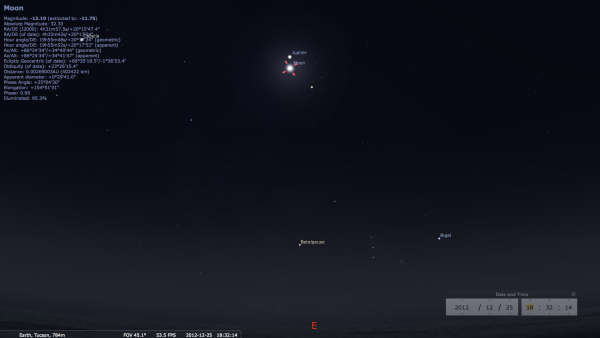So after you finish your Christmas dinner, take a step outside and you can get a nice view of the waxing gibbous Moon very close to Jupiter if you live in the continental United States (if you are really lucky and live in South America, you can see the Moon pass directly in front of Jupiter and block it out for a while! Would love to see this one!) Here is a chart of what it will look like from Tucson at about 6:30pm local time.
There are lots of neat things you can observe. First, the Moon will rise a couple of hours before the Sun sets (in Tucson the Moon rises at 3:34pm and the Moon sets at 5:25pm). Since Jupiter is so close to the Moon, this gives you a chance to spot Jupiter during the day. It will help if you have a pair of binoculars. Jupiter will be in the same field of view as the Moon in most binoculars. Once you spot Jupiter with binoculars and know where it is, can you spot it before the Sun sets? Most people can find Jupiter during the day with binoculars but it is challenging to see it without optical aid. See how early you can spot Jupiter.
Once the Sun sets, all four Galilean Moons will be visible. This is a good time to break a telescope someone got as a Christmas gift and train it on the Moon and Jupiter (you probably won't be able to see both at the same time through a telescope unless you have a very wide field telescope).
Another good observation to make is note how fast the Moon moves relative to Jupiter. They are closest together about 6:30pm EST and the Moon moves about one half degree per hour. One half degree happens to be about the diameter of the Moon. With a nice bright reference point like Jupiter nearby, you should be able to observe this motion over a couple of hours with just your eyes, no telescope required. Better yet, take a picture of them early in the evening and then go out later and take another picture (just be sure to use the same zoom setting and mounting the camera on a tripod is essential!) I have done this with point and shoot cameras that have as little as a 3x zoom lens way back in 2004 and modern inexpensive cameras are much better than what I was using back then!
Although this is a nice conjunction, if you miss it, the Moon will come around for an even closer conjunction with Jupiter in January, but that is a future blog!
Reprinted with permission from the Half-Astrophysicist Blog.






4 comments:
Boppster, what is the difference between a conjunction and an eclipse? Sounds pretty close to me…
The term eclipse refers to events involving our Sun and Moon. One body enters the shadow of the other.
A conjunction can involve a combination of our Moon, planets and stars and one object does not necessarily pass directly in front of the other. Astronomers measure coordinates in the night sky similar to how we do on the surface of the Earth. Right Ascension tells you how far east or west the object is (like longitude on the Earth) and declination is used to measure how far north or south an object is (like latitude). A conjunction occurs when two objects have the same right ascension but they may have a different declination. If both right ascension and declination are the same, then one object is in front of the other and it is called an occultation.
Just to make things really confusing, the time of the conjunction is not necessarily the time the two objects appear closest together in the sky. Since the objects may not be moving directly east to west, they may have their closest approach before or after the conjunction (since conjunction only tells you when one of the two coordinates is the same).
In the end, it all comes down to definitions which can be a little arbitrary.
Science is fun.
Thanks Boppster....
So if I have it right, an eclipse is in a straight line compared to a conjunction which could be the angle of the dangle....
Post a Comment